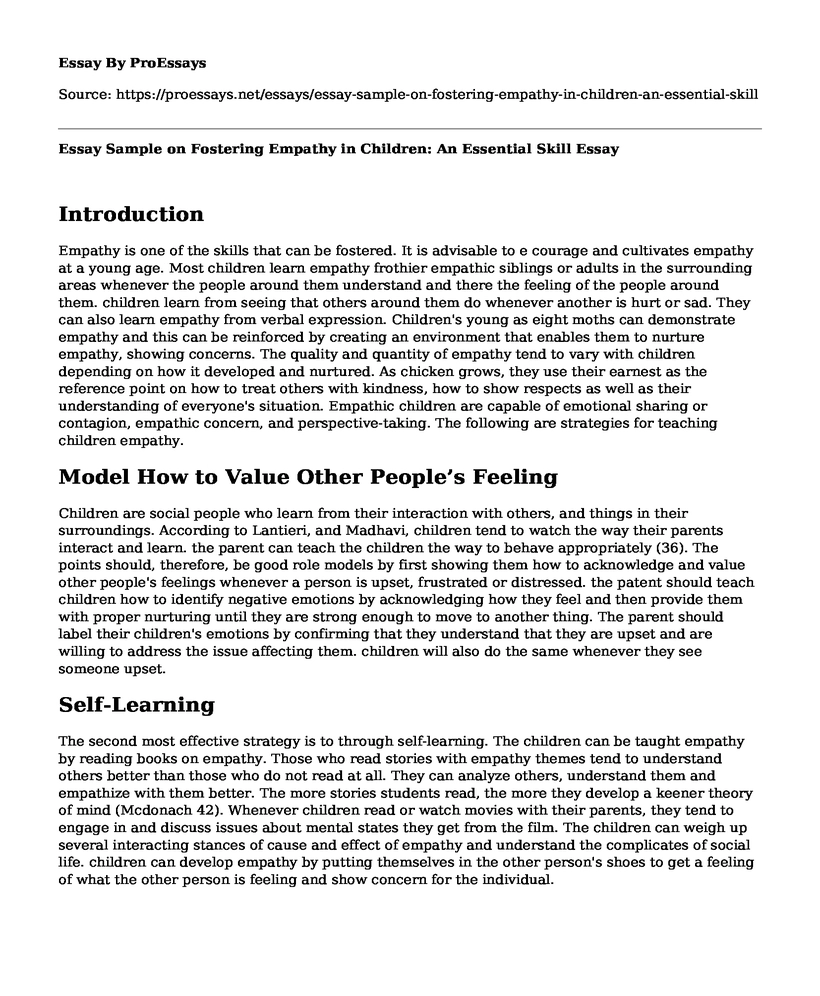Introduction
Empathy is one of the skills that can be fostered. It is advisable to e courage and cultivates empathy at a young age. Most children learn empathy frothier empathic siblings or adults in the surrounding areas whenever the people around them understand and there the feeling of the people around them. children learn from seeing that others around them do whenever another is hurt or sad. They can also learn empathy from verbal expression. Children's young as eight moths can demonstrate empathy and this can be reinforced by creating an environment that enables them to nurture empathy, showing concerns. The quality and quantity of empathy tend to vary with children depending on how it developed and nurtured. As chicken grows, they use their earnest as the reference point on how to treat others with kindness, how to show respects as well as their understanding of everyone's situation. Empathic children are capable of emotional sharing or contagion, empathic concern, and perspective-taking. The following are strategies for teaching children empathy.
Model How to Value Other People’s Feeling
Children are social people who learn from their interaction with others, and things in their surroundings. According to Lantieri, and Madhavi, children tend to watch the way their parents interact and learn. the parent can teach the children the way to behave appropriately (36). The points should, therefore, be good role models by first showing them how to acknowledge and value other people's feelings whenever a person is upset, frustrated or distressed. the patent should teach children how to identify negative emotions by acknowledging how they feel and then provide them with proper nurturing until they are strong enough to move to another thing. The parent should label their children's emotions by confirming that they understand that they are upset and are willing to address the issue affecting them. children will also do the same whenever they see someone upset.
Self-Learning
The second most effective strategy is to through self-learning. The children can be taught empathy by reading books on empathy. Those who read stories with empathy themes tend to understand others better than those who do not read at all. They can analyze others, understand them and empathize with them better. The more stories students read, the more they develop a keener theory of mind (Mcdonach 42). Whenever children read or watch movies with their parents, they tend to engage in and discuss issues about mental states they get from the film. The children can weigh up several interacting stances of cause and effect of empathy and understand the complicates of social life. children can develop empathy by putting themselves in the other person's shoes to get a feeling of what the other person is feeling and show concern for the individual.
Connecting Feeling with Their Thoughts and Behaviors
Children should be taught how to behave in a manner to show that they have deep emotions. Parents and teachers should show genuine concerns. This way, they will understand the relationship between cause and effect. Through play-acting and reading stories, the children can learn how one person's behaviors affect the other person's emotions, feeling and thoughts. Children can also be tight about how their thoughts affect their behavers and feelings and the impact these have on the people around them (Lantieri, and Madhavi 28). For older children, they should e taught how to take the perspective of another person in distress. Asking them how they feel what might have caused the bad feeling and what can be done to help will help them learn how to react whenever they see one is affected.
Conclusion
In conclusion, empathy can be learned from stories, or modeled in children. From the studies, people felt illuminated and instructed by stories they read, movies they watch or the people with whom they interact. The parents and teacher should, therefore, create an environment that fosters empathy.
Works Cited
Mcdonach, Mary. "I Feel for You How to Teach Your Blind Child about Empathy and Social Interaction." Future Reflections, vol. 36, no. 1, Winter 2017, p. 38. EBSCOhost, search.ebscohost.com/login.aspx?direct=true&db=prh&AN=123581845&site=eds-live.
Lantieri, Linda, and Madhavi Nambiar. "Cultivating the Social, Emotional, and Inner Lives of Children and Teachers." Reclaiming Children & Youth, vol. 21, no. 2, Summer 2012, pp. 27-33. EBSCOhost, search.ebscohost.com/login.aspx?direct=true&db=i3h&AN=79318057&site=eds-live.
Cite this page
Essay Sample on Fostering Empathy in Children: An Essential Skill. (2023, Mar 12). Retrieved from https://proessays.net/essays/essay-sample-on-fostering-empathy-in-children-an-essential-skill
If you are the original author of this essay and no longer wish to have it published on the ProEssays website, please click below to request its removal:
- Motorcycle Man
- The Evidence-Based Practice Capstone Project Evaluation Paper Example
- Investigation of Behavioral Management Policies in School Paper Example
- Critical Thinking about College Graduates
- Essay Sample on Standardized Testing in K-12 Education
- Essay Example: What Is Home? My Perspective on the Meaning
- Cultural Awareness at American River College







